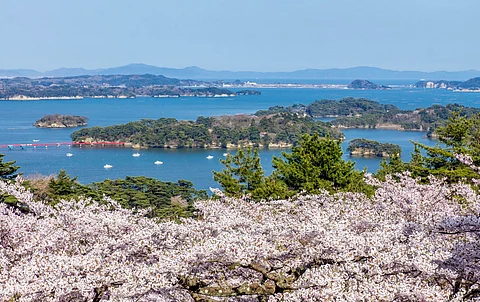

When revered haiku poet, Matsuo Basho, first visited Matsushima, he was rendered speechless.
From a distance, the two hundred and sixty tiny islands (shima) covered in pine (matsu) appear like bonsai trees sprouting out of moss covered rocks. Four main islands, the "Matsushima Shidaikan", provide the most stunning scenic vistas of Japan's natural aesthetic. Paths winding though manicured Zen landscapes, and around inlets frothed by ocean waves reflecting a bleached-white sun, are worn by young carefree couples in love, and elderly groups on mid-day walks.
The quiet village of Oku-Matsushima, set on the scenic coast of Miyagi Prefecture, is quietly earning a reputation as one of Japan’s most compelling rural destinations. Its blend of nature, history, and community-led tourism recently drew international attention through a Japan National Tourism Organization (JNTO) video, “Where all roads lead home”, which received a Silver Award in the Sustainability/Responsibility category at the 2025 Drum Awards for Marketing APAC. The Drum Awards, established in 2014, celebrate exceptional marketing and creative work that engages, inspires, and achieves significant brand impact.
The video, which follows the daily life of a local oyster fisherman, highlights the village’s deep connection to its natural surroundings and its efforts to preserve local traditions. While recognition like this has helped introduce Oku-Matsushima to a broader audience, its charm lies in its centuries-old heritage and forward-looking community.
Though heavily impacted by the 2011 earthquake, Oku-Matsushima has rebuilt itself through community resilience and sustainable tourism. In 2023, the village was named one of the “Best Tourism Villages” by UN Tourism, further validating its commitment to responsible development and cultural preservation.
One of its most remarkable features is the Satohama Shell Mounds—archaeological sites that offer a glimpse into daily life in prehistoric Japan, dating back thousands of years. Items such as oyster shells and human remains offer evidence of early human life in harmony with the land and sea.
The surrounding area, including Matsushima Bay, is protected under Japan’s Law for the Protection of Cultural Properties. Nearby, the Satohama Jomon no Sato Historical Park invites visitors to explore a natural landscape shaped by the sea and forest and is often referred to as an open-air museum.
In 2018, the village introduced the Oku-Matsushima Olle Trail, a 10-kilometer hiking course modeled after the Korean Olle trail system. The route weaves through picturesque coastlines, forests, and residential alleys, immersing visitors in the village’s story—from its ancient roots to its recovery after the tsunami. By the end of 2024, the trail had welcomed more than 37,000 hikers, including many international visitors.
In February 2025, local residents and tourism professionals came together to organize sightseeing boat tours and coastal conservation workshops, offering visitors deeper insights into Oku-Matsushima’s natural environment and its vision for mindful, community-driven tourism.
Oku-Matsushima is more than a scenic village—it is a living example of how heritage, nature, and community resilience can shape the future of rural tourism.